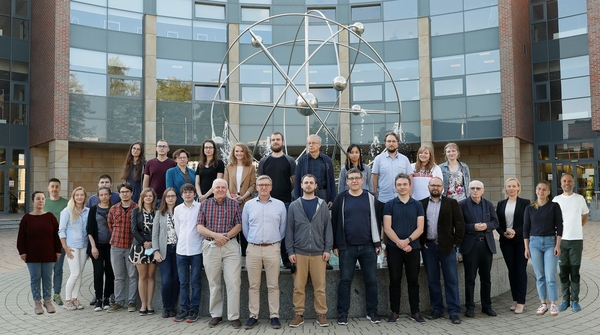load('carousel_en.html');
?>
Department of Physics of Nanostructures and Nanotechnology
render(['carousel' => [
[
'path' => '/img/baner/lab-1.png',
'caption' => 'Low-temperature Scanning Tunneling Microscope (LT-STM) lab'
],
[
'path' => '/img/baner/rt-stm.png',
'caption' => 'Inside of the Room Temperature STM (RT-STM) vacuum chamber'
],
[
'path' => '/img/baner/stm-raman.png',
'caption' => 'STM-Raman Biolab'
],
[
'path' => '/img/baner/banner_computational.png',
'caption' => 'Modeling of sputtering phenomena'
],
[
'path' => '/img/baner/ge001.png',
'caption' => 'Ge(001) before and after gold evaporation and annealing'
],
[
'path' => '/img/baner/sam.png',
'caption' => 'Self-assembled monolayer formed by BIM molecules on the Au(111) surface'
],
[
'path' => '/img/baner/fluor.png',
'caption' => 'Fluorescence image of an endothelial cell'
],
[
'path' => '/img/baner/bio-baner3.png',
'caption' => 'Depolymerized F-actin fibres of the endothelial cells (left) and calcium stained of single endothelial cells (right)'
],
[
'path' => '/img/baner/defects.png',
'caption' => 'Atomic-scale defects on the Si(001):H surface'
],
[
'path' => '/img/baner/mos2.png',
'caption' => 'Au islands on the MoS2 substrate'
],
[
'path' => '/img/baner/synthesis.png',
'caption' => 'Synthesis of HBC molecules at the nanoscale: concept and practical implementation'
],
[
'path' => '/img/baner/baner-jpk-afm.png',
'caption' => 'Endothelial cells characterized simultaneously with AFM and fluorescence microscopy'
],
[
'path' => '/img/baner/vt-banner.png',
'caption' => 'VT-Omicron microscope and images of PTCDA molecular chains on InSb(001) c(8x2) and TiO2(001) surfaces'
]
]]);
?>

The phenomena taking place in the nanoworld and the physical laws governing there may be significantly different from those we know from the macro world. When one shrinks materials to the nanoscale, an impressive change in their physical properties occurs compared to their macro counterparts; their properties become highly dependent on size and shape. Investigation of nanomaterials and nanostructures is a relatively new and fascinating field of science.
Our department studies this nanoworld exploring its various frontiers. Our research ranges from the fundamental approaches aimed at the modeling of surface phenomena at the atomic level, through the preparation of self-assembled monolayers with a precisely tailored geometrical structure and unique chemical properties, fabrication of nanometer-size complex organic assemblies by controlled manipulation of individual organic molecules, into studies of physicochemical properties of various biosystems at the nanometer level.
